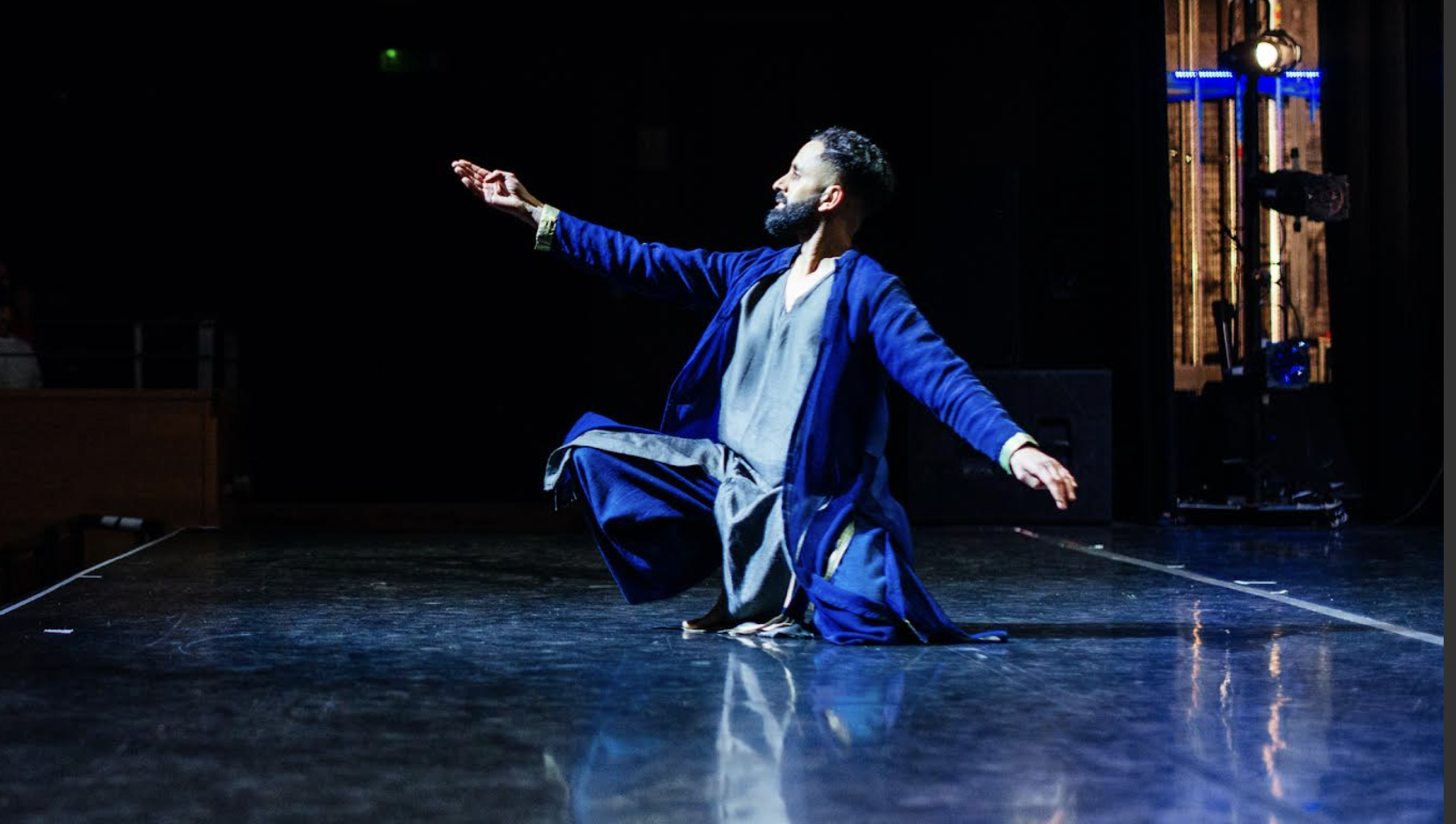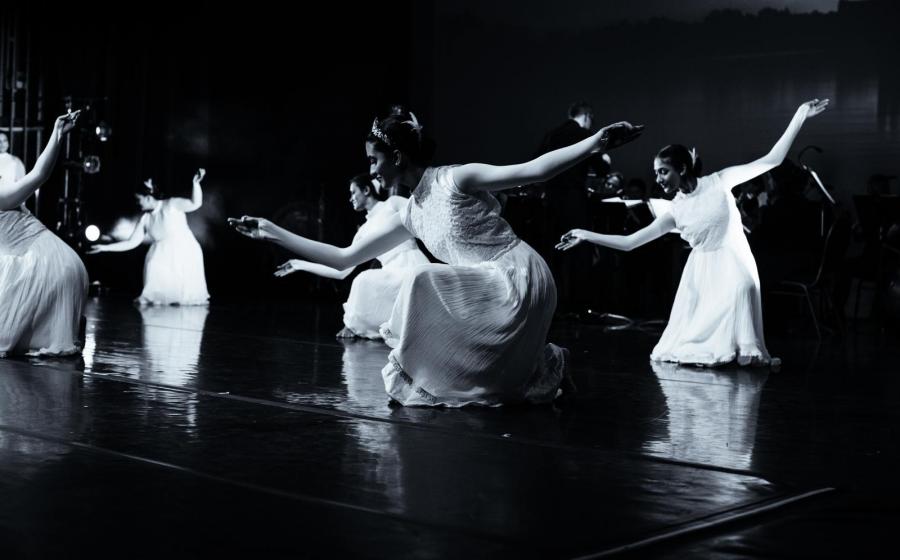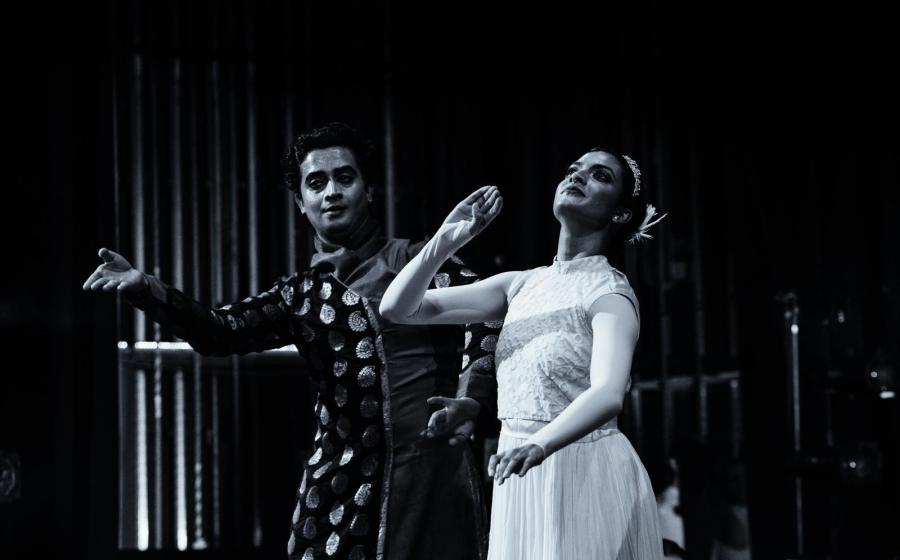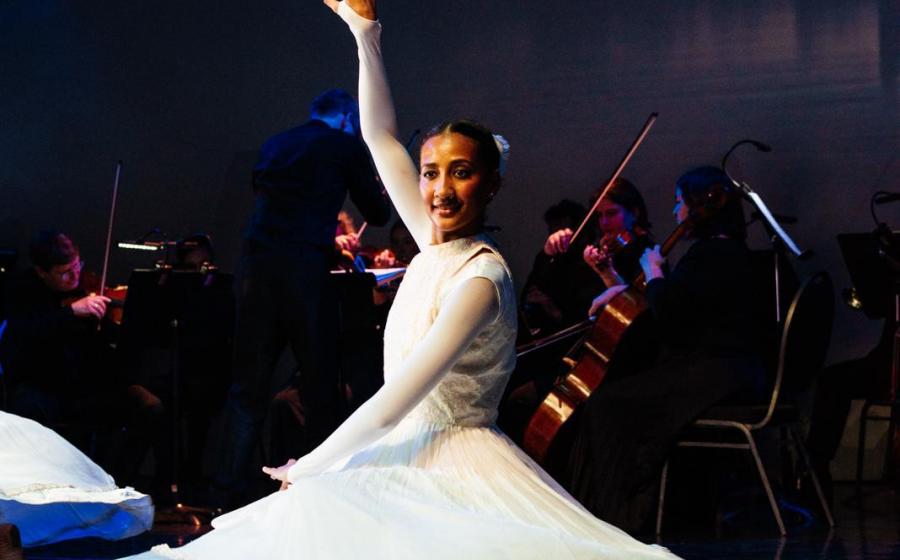Hemantika Festival-Sujata Banerjee Dance Company
Arts Depot, London
10 November 2024
Reviewed by Sanjeevini Dutta & Stacey Prickett
The annual Hemantika Festival produced by Sujata Banerjee Dance Company (SBDC) is in its ninth edition and has built up a core of dedicated young followers. The foyer at the 6.30 performance was buzzing with excited voices. The earlier programme of the day had featured a number of SBDC student groups and guest artists ClimArts – an odissi duo and kathak dancer Sambhavi Dandekar from the US.
The later programme had three sections: SBDC’s Youth Group; invited kathak artist, the internationally-renowned Aakash Odedra (reviewed below) and finally a group of dancers recruited for an excerpt from Swan Lake Re-imagined. The young dancers performed Bandishee Kathak, a nritta item which combines different elements of the kathak form held together in a melodious composition. The rigour of their training and rehearsal standards were evident in unison spins, sharpness of attack, and clear detail of head and arm gestures. Choreographed with groups at varying stages of progression, the dancers moved seamlessly in and out of spatial patterns, with strong and clear tatkar.
Swan Lake Re-imagined was a risky enterprise: to create an aura of expansiveness, the grandeur of royal palaces and a spectacular frozen lake requires resources and a vision. Some of the simple devices proved to be very effective: resetting the story in an Indian landscape with the narrator taking the form of Goddess Saraswati, the patron of knowledge music and the arts; the projection of a moonlight sky with a domed outline changing briefly to the interior of a grand hall for the ballroom scene.
An orchestra of seventeen musicians, fourteen from The Royal Philharmonic Orchestra (now relocated in Brent, where SBDC is based), played the score adapted by Howard Moody from Tchaikovsky’s Swan Lake, augmented by tabla, sitar and flute to lend some Hindustani inflection. The first scene introduced us to Prince Siegfried celebrating his birthday, before heading to the lake where Odette lives with her swan maidens, enchanted by the evil spell of the wizard Rothbart. Movement echoes of the traditional ballet choreography are seen in the swan maidens’ arms held low and crossed at the wrists, while undulating arms evoked wings in flight. A duet between Odette portrayed by Vidya Patel and her Prince Shubham Keshri embodied a growing love, interrupted by the protective group of swan maidens who physically surround and separate the two lovers. They moved in and around them, hopeful of breaking the spell that held them captive as swans, while also fearful of heartbreak. Performed in front of the small orchestra, the intricacy of group patterns was impressive as lines of dancers established a wall of resistance, moving to encircle Odette, their swan queen. The condensed narrative conveyed the betrayal and power of Rothbart whose curse condemns Odette to die, although the swan maidens ultimately overpower the wizard in a final confrontation of a whirlwind of turns and percussive footwork. Although the group action was reminiscent of the well-known corps de ballet, the choreography did not feel derivative, such was its grounding in classical kathak.
The true delight of the thirty-minute show is the performance of the swan chorus. Their focus and commitment are intense. They carry the show helped by the narration, the simple projected set and the effective costuming. Sujata Banerjee pours her four decades of kathak experience into creating this most joyful and entertaining piece which embraces the best of east and west.
Appreciation of Aakash Odedra
Stacey Prickett

Aakash Odedra’s guest appearance at the Hemantika Festival opened with a focus on nritta. Standing with his back to the audience, his arms moved slowly up and overhead, exuding a calm aura that dissipated quickly. Moving gradually downstage, a lesson in cool virtuosity ensued. The lack of ghungroos was unexpected but strong percussive footwork was surprisingly audible. Odedra consumes space with a light movement quality that is deceptive, such is the complexity of his dynamic qualities. Movement styles are blended, with kathak in the footwork and turns, bharatanatyam-influenced leaps and fluidity in the torso evoking contemporary dance. Graceful gestures gather energy that shifts as his hands hit their mark like an arrow. A study in contrasts plays out, as a sudden leap seemingly held in the air travels halfway the stage, rapid spins carve out patterns that reach the corners. In travelling steps like bourrées in ballet, the feet accent the accompanying instrumentation while the torso remains steady. Unpredictable in pathways and levels, Odedra is as comfortable in spins on his knees as on his feet. An elegant dancer, the pulse he creates is infectious. The circular rhythmic journey resolved when he returned to the opening stance, bringing us back to stasis.
The second piece titled Allah Hoo (a Sufi chant) featured vivid abhinaya blending figurative imagery with Sufism. Choreographed by Delhi-based Rani Khanam (Songs of the Bubul) with original score by Rushil Ranjan and vocals by Abi Sampa, a pool of light reveals Odedra on the floor. Coming to life, he explores the space, embodying birds in flight, scented flowers blooming, the warmth of the sun and breezes. Arm gestures and the sense of yearning animate the atmosphere, as whirlwinds of movement echo whirling dervishes that convey a freedom and abandonment. A fluidity and expansiveness take the action beyond the body in mesmerising spirals that course up from the feet through the torso and out into space. Spatial patterns are enhanced by a long skirt floating through the air and continuing the circular flow. Here the blend of lightness and sharp attack is intensified through its contrast with intricate and floating arms and hands, his leaps and floor spins taken to the extremes. As a soloist, Odedra defies the intimacy of the lone dancer, celebrating nature and spirit. The rich complexity of speed and stillness, lightness and groundedness, freedom and emotional intensity provided a soul-restoring joyful interlude to a rewarding evening.






















